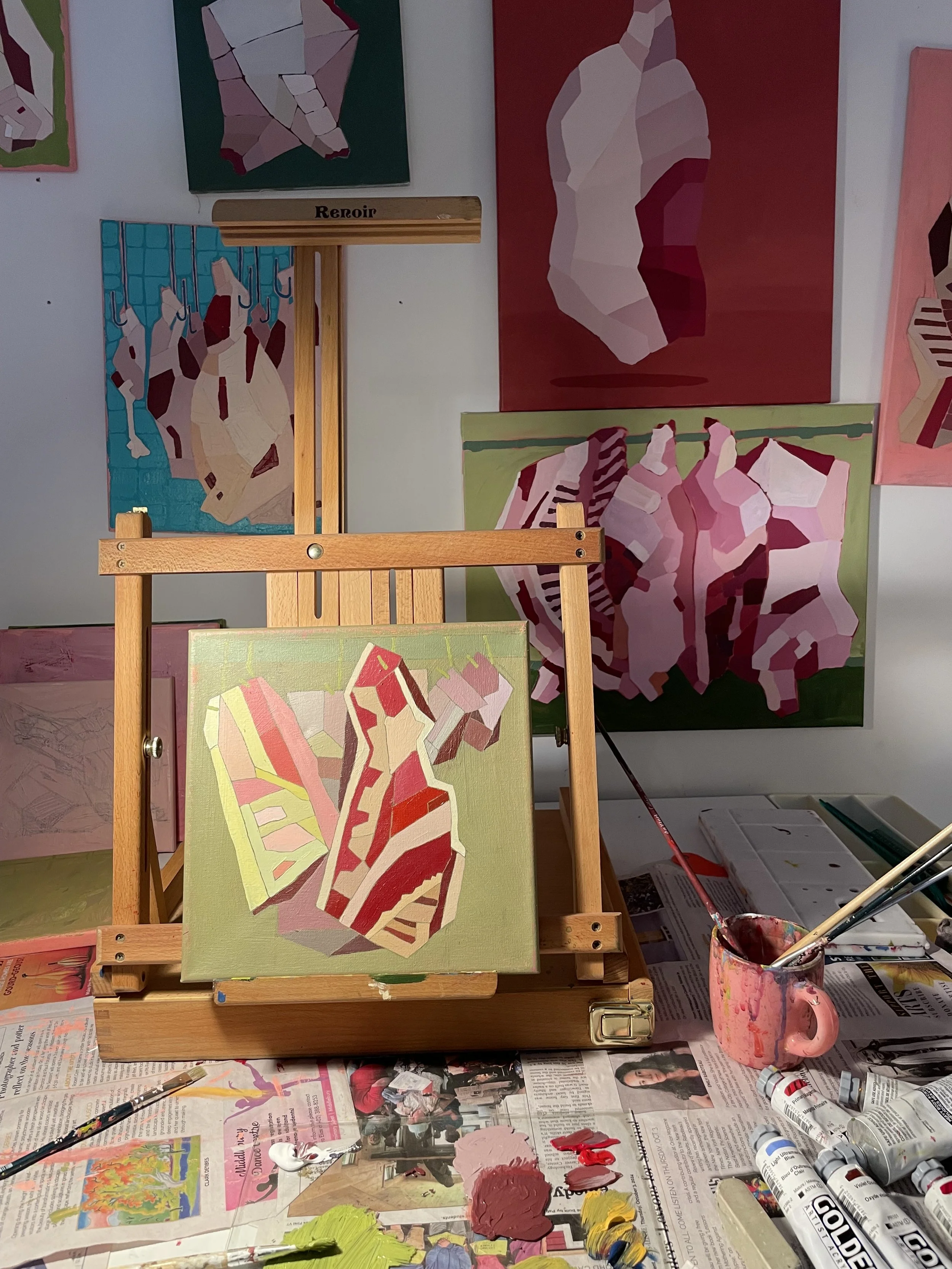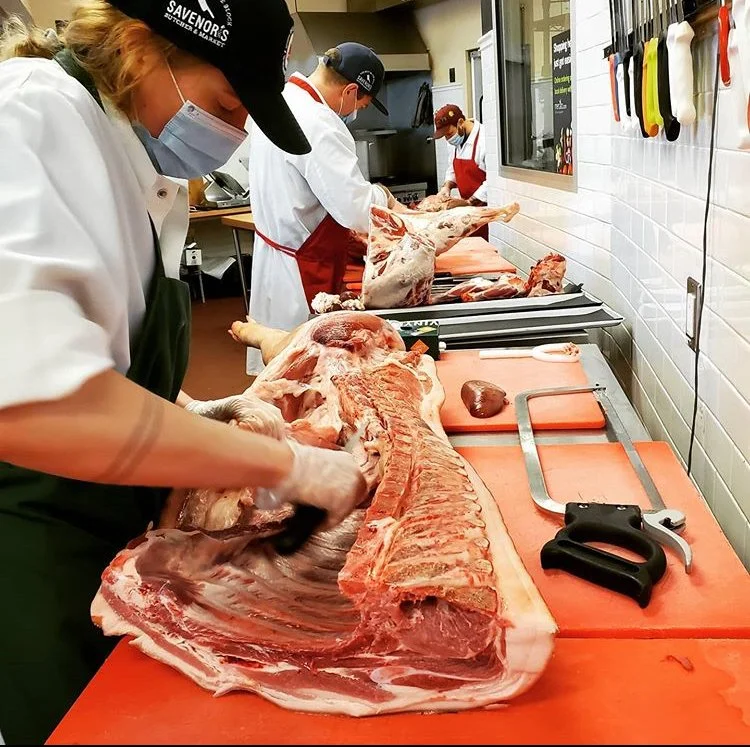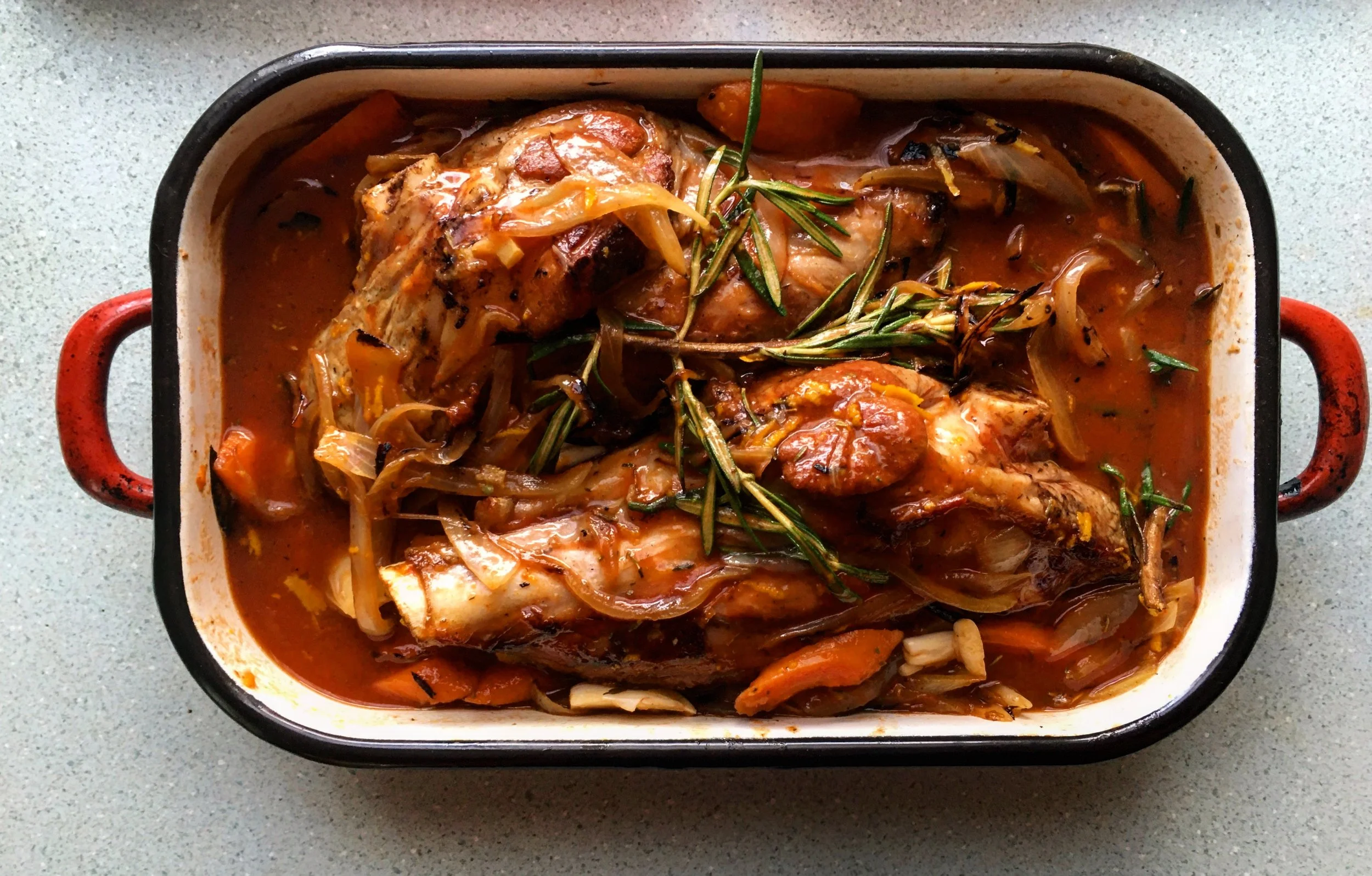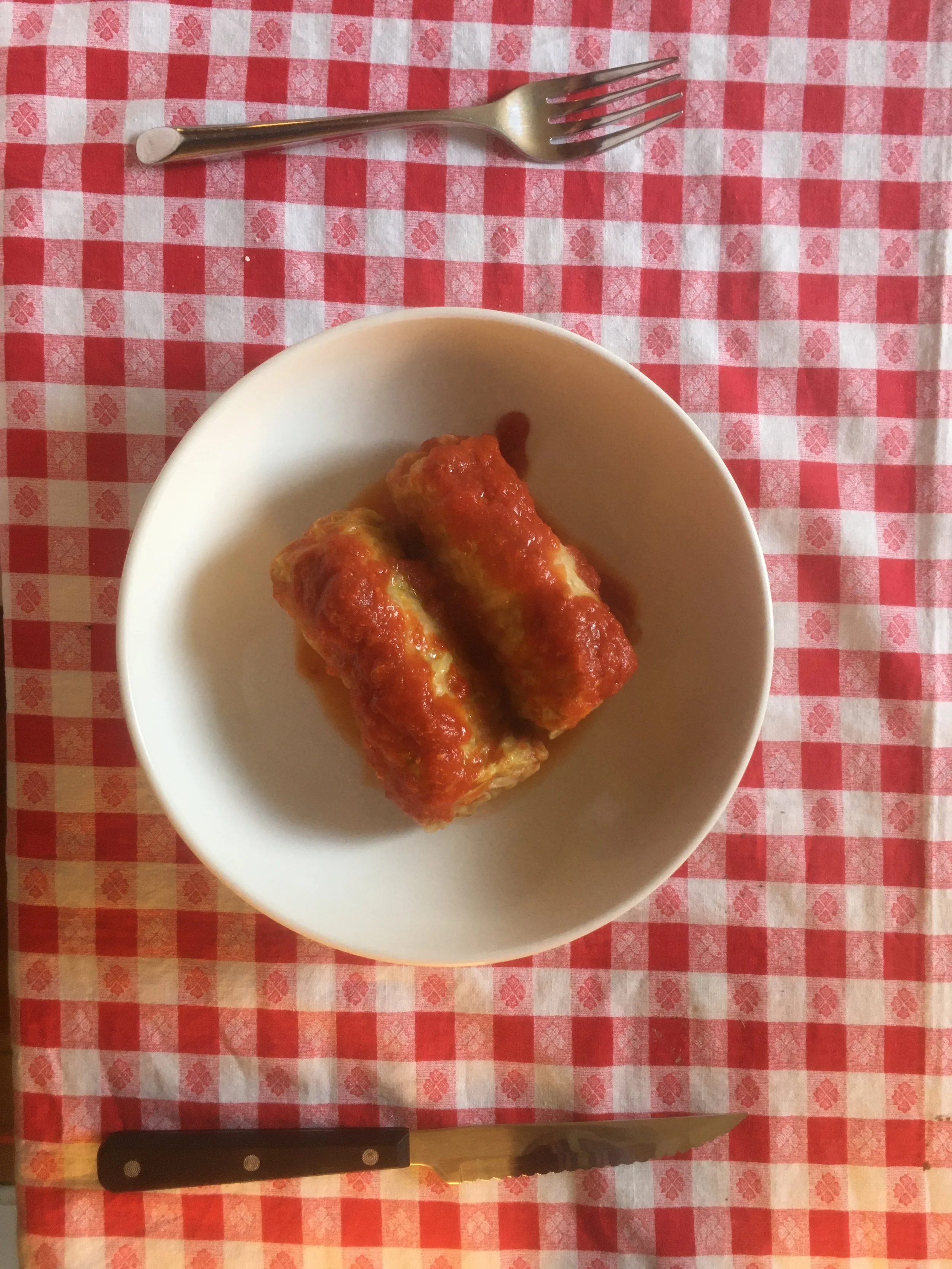Hannah Clark
This spring at Minifactory, butcher Hannah Clark collaborated with me to bring our Grass Supper Animal Supper Series to life. Hannah is an artist and gardener, a knitter, a conversationalist and a wonderful cook who we’ve been so lucky to work with in the kitchen at Minifactory. When you cook with someone, you learn about them in between trips to the walk-in (“be right back, hold that thought!”) and lots of noisy pauses while the blender runs and emulsifies a vinaigrette for lunch service. Here, we were finally able to settle into a longer conversation and dive into her evolving relationship with animals and agriculture.
Hannah Clark milking Guinness the cow.
V Smiley Preserves: You’ve lived in multiple states over the last 10 years, from rural farm settings in Maryland and Vermont to growing up in CT outside New Haven to years spent in Boston. What have the through lines been through each home setting? Are there any traditions you carry from each place or experiences you seek out when you arrive somewhere?
Hannah Clark: I really value taking time to get to know places personally, especially by walking, biking, and public transit. I find it very grounding when I arrive at a new home to explore it and get a little lost. When I first moved to Boston I would take the T to the end of the line and wander back. It took a long time, but eventually I knew how to get everywhere. This has always helped me establish routine and community as I move to a new area. I want to know all the shortcuts, figure out the best market to buy cheese, and which restaurant has good menu specials. In a rural setting I take a similar approach: get on the bike, take in the scenes, and see how far I can get.
Hannah’s first pâté en croûte, a French charcuterie dish consisting of a pâté, or forcemeat, encased in a crust and baked.
VSP: Take us back to a weeknight dinner as a kid. Were you involved? Who’s cooking night to night and what are you eating? Did these meals change over time?
HC: My mom cooked most nights, with some serious hovering from my sister and I for a pre-dinner snack. Our main role was: set the table, wash a dish or two, take the dog out, and help with prep. My mom created some really comforting dishes; curry chicken pot pie with biscuits, meatloaf and mash, sloppy joes, tofu and broccoli. My mom has this thick family recipe book, full of pages she has collected from anyone and everyone, all scribbled in different handwriting. It has all the best cookie recipes.
VSP: How did you realize you liked working with your hands?
HC: Very early on. I come from a creative family where making with your hands was celebrated. My first job was at the Eli Whitney Museum, a creative learning space/woodshop/summer camp combination. I apprenticed there from the age of 13, where I learned how to use drill presses, design objects and make models. My Dad actually also learned there as a child, where he made a steam cannon and learned how to sweat pipes; skills which he later taught me through the same project, at age 10. I was there for 8 years total, and it has influenced so much of how I experience the world and how I approach my art practice now.
Painting by Hannah Clark
Painting by Hannah Clark
VSP: What have been influential experiences, people or places for you?
HC: For me, It has to be the two most influential places I worked, and the women in my family. On a whim, I applied to work as an apprentice at Stony Creek Farmstead between semesters at college. At the time I was a vegetarian art student. I think about that summer often. It was the first time I had eaten food straight from the garden, spent time with animals bigger than a dog, milked a cow by hand, and slaughtered my first chicken.. I got addicted to that lifestyle, being surrounded by bounty and incredible food. I went back to school and dropped out. I knew I needed to be connected to the food system, and I wanted to be around agriculture, but wasn't ready to leave my city lifestyle and community.
Unsure of what to do, I saw a job posting for a butcher's apprentice at Savenor’s. What I thought might be a year max while I got myself figured out has turned into a 7 year long career of cutting meat, making sausage, and teaching others. I was inspired by the folks I worked next to every day and by my mentor Christopher Walker. His passion for the industry, the farmers, the animals, the flavors, was absolutely contagious.
I’d also be remiss if I didn’t mention the women in my family as inspiration. My Mom and Grandma are magnetic; when they throw a dinner party, people are getting new jobs, folks are getting in new relationships, they know how to make people feel seen, celebrated, and fed.
Hannah Clark cutting at Savenor’s
Hannah Clark with her mentor Christopher Walker, teaching at Future Chefs.
VSP: How has your relationship to animal based agriculture shifted over time?
HC: When I first explored my relationship with the meat industry my solution was simply not to eat it. If I couldn't afford to support the farms I felt were supporting the land and animals, I just avoided it. But as I grew closer and closer to the industry I began to prioritize putting my dollar not towards the tofu industry but towards the farmers and growers who were doing the work in the meat industry. Due to my experience in working on dairy farms, veg farms, and meat farms, I am constantly reminded that food is all about relationships, knowing the person growing your food.
Food can be very social. How has it created community in your life?
One of the things I value about the rural nature of Vermont is that you have to be so intentional in how you spend time with each other. I love a shared meal. I just want to invite everyone to my house and feed them their favorite dish (I get that from my Mom).
When I first began eating meat again, I would take home a new cut every week for ‘Monday Night Dinner.” I would learn to braise and fry, and how to cook a perfect steak. I invited all my friends over to be fed. In that particular apartment we had a kitchen but no communal spaces, so these elaborate dinner parties would be in my attic bedroom. I would put a sheet on top of a desk to use as a table, and the conversations would last all night. It really showed me that you don't need much to make a memorable and delicious evening.
One of my biggest public art pieces I’ve made embodied much of this. “The Dinner Table Project” was a collaborative, communal hodgepodge of artists, makers and accessible food initiatives, created as a response to the food insecurity so many artists face. It was a space to gather, have difficult conversations, and put on a performance of nourishment.
Citrus braised lamb leg.
What are some of your favorite food inspirations?
HC: I am constantly diving back into dishes that bring comfort and celebrate the simple. I go back to the same cookbooks often, or look through family recipes. Typically I am just inspired to cook by the changing seasons or what is in the pantry. My mom, pretty much daily, would say “all you need is here.” That idea was always very present in her kitchen, and in mine too. “Following a recipe and you have X? Just add Y instead, it's all here.”
The two cookbooks I can't stop rereading are “River Cottage Meat Book” by Hugh Fearnley-Whittingstall, and “Meat: a Kitchen Education,” by James Peterson. I also love my monthly dose of Bon Appetit magazine– the recipes are so well-tested, and visually it’s such a stunning magazine to spend time with.
VSP: Are there any misconceptions around meat that you hear often-repeated and feel you can uniquely speak to through your work as a butcher?
HC: People often think of slaughter and butchery as aggressive, gory and inhumane, but my view is entirely opposite. I think to do this work you have to be extremely tender, calm, and have a deep love and respect for the animals you're working with. The first time I experienced an on-farm lamb slaughter I remember being so impressed at the way farmer Mike Kirk of Greylaine Farm navigated the animal, bringing an intense calm and stillness to the situation, both before and after. The entire slaughter process is so important to all the years of work that go into raising an animal. Too stressful of a slaughter environment and the meat will be spoiled. Slaughterhouse workers care about animals and are working so diligently to process those animals into nourishment for their community.
Hannah’s attempt at making her grandma’s Golumpki.
VSP: How would you like to see the meat industry morph in Vermont?
HC: I would love for more accessible slaughter, processing and value-add. Being in such a rural environment there are very few slaughterhouses, and the wait can be 1-2 years. We have already seen the beginning of this through the work of Rural Vermont, advocating for legislation allowing more on-farm slaughter and processing, and through the work of New England Mobile Slaughter, allowing farmers to have animals killed on their farms and brought directly to the processor.
I have folks reach out asking me where and how they can learn to cut meat and I don't entirely have an answer. I would love to see a more robust butcher training program in Vermont.
VPS: What are some favorite items that others have cooked for you?
HC: Firstly, my grandma's Swedish Meatballs. They have some secret ingredients to them, and though I've tried to make them, they never come out quite like hers. Secondly, My dear friend makes a potato and lemon lentil salad. It's her go-to for a potluck and I look forward to it every time I see she will be there. Lastly, a few years back I was helping with a community slaughter, and we took a lunch break and they had cooked up an incredible meal. Organ spice meatloaf, kraut made from the season before, kabocha squash hunks. Warm, flavorful, and comforting. I think about that meat loaf all the time.
VSP: You have a couple days off in the winter, what might you get up to? How does this change in the warm months?
HC: In the cold months I’d pop dinner in the oven, maybe cider- braised goat and cabbage, head up to the studio to work on my painting practice, get a good cold walk done or maybe a winter dip in Lake Champlain. Maybe that evening I would have a friend or two over for a drink and a laugh. Blissful Vermont winter day.
However, in the warmer months I just can’t be inside. I entirely abandon my art practice and need to be swimming, pulling weeds in the garden, reading in the sunshine, grilling over the open fire, or eating blueberries by the pound. I enjoy the seasonal routine that Vermont brings to my creative practice and balance to my life; built-in rest and hustle.
Hannah Clark









